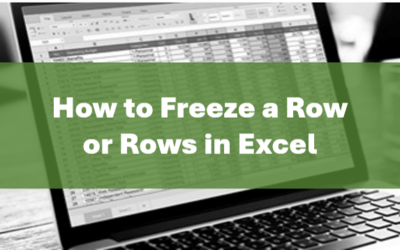Microsoft Excel 2010 Version Overview
The following is a list of some of the key new features in Microsoft Excel 2010.
If you are upgrading to Excel 2013 or 2016, check out key new features in our Microsoft Excel 2013 Version Overview or Microsoft Excel 2016 Version Overview.
Are you working with 2007? Check out the Microsoft Excel 2007 Version Overview.
Looking for Excel training courses?
Microsoft Excel 2010 New Features
Applies to: Microsoft Excel 2010 for Windows
The following are some of the key new features available in Microsoft Excel 2010.
File Tab (Backstage View)
In 2010, the Office button has been replaced with a File tab on the Ribbon (also called Backstage View). Here you will find common commands such as Save, Open, New and so on.
Customize the Ribbon
In Excel 2010, you can now customize the Ribbon and add your own tabs. Click on the File tab and then choose Options. In the dialog box, click on Customize Ribbon on the left. You can add new tabs and add buttons to new tabs or existing tabs.
Display Trends using Sparklines
You can add miniature charts called Sparklines to cells to summarize trends. You can add line, column and win/loss Sparklines and a new Sparkline tab will appear to format the Sparklines.
Improved PivotTables and PivotCharts
PivotTables have received some improvements in 2010 which include:
- Performance enhancements – multi-threading helps speed up data retrieval, sorting, and filtering in PivotTables.
- PivotTable labels can be filled down in a PivotTable. You can also repeat labels in PivotTables to display item captions of nested fields in all rows and columns.
- Enhanced filtering using Slicers to quickly filter data in a PivotTable without having to open additional menus.
- Filter interface includes a search box that can help you to find what you need in your PivotTables.
- The Show Values As feature includes a number of new, automatic calculations, such as % of Parent Row Total, % of Parent Column Total, % of Parent Total, % Running Total, Rank Smallest to Largest, and Rank Largest to Smallest.
- It is now easier to interact with PivotChart reports as you can filter data directly in a PivotChart and reorganize the layout of a PivotChart by adding and removing fields. You can also hide all field buttons on the PivotChart report.
- Write-back support – In Excel 2010, you can change values in the OLAP PivotTable Values area and have them written back to the Analysis Services cube on the OLAP server. You can use the write-back feature in what-if mode and then roll back the changes when you no longer need them, or you can save the changes. You can use the write-back feature with any OLAP provider that supports the UPDATE CUBE statement.
Improved Conditional Formatting
Excel 2010 includes new conditional formatting options:
- In Excel 2010, you have access to more icon sets including triangles, stars, and boxes. Also in 2010, you can customize icon sets.
- Excel 2010 provides new formatting options for data bars. You can apply solid fills or borders to the data bar or set the bar direction from right-to-left instead of left-to-right. Also, data bars for negative values appear on the opposite side of an axis from positive values.
- When specifying criteria for conditional or data validation rules, it's now possible to refer to values in other worksheets in your workbook.
Business Intelligence with the PowerPivot for Excel add-in
If you need to analyze large data sets, you can download the PowerPivot for Excel add-in, which adds a PowerPivot tab to the Excel Ribbon.With PowerPivot for Excel, you can import large amounts of data from multiple data sources into a single Excel workbook, create relationships between tables of data, create calculated columns and measures using formulas, build PivotTables and PivotCharts and then further analyze the data.
Improved Solver add-in
Excel 2010 includes a new version of the Solver add-in which you can use to find solutions in what-if analysis.
Enhancements include:
- Improved user interface
- A new Evolutionary Solver (based on genetic algorithms that handles models with any Excel functions)
- New global optimization options
- Better linear programming and nonlinear optimization methods and new Linearity and Feasibility reports
- Solver is also now available in a 64-bit version.
ADDITIONAL RESOURCES
Check out our blog for more Excel tips, tricks and shortcuts.
Public courses are delivered at our downtown Toronto location at 1 Yonge Street, Suite 1801 (Toronto Star Building), Toronto, Ontario, Canada.
Avantix Learning Excel Courses | Frequently Asked Questions (FAQs)
Do you need more information? Contact us!
Copyright 2017 Avantix Learning Inc.
To request this page in an alternate format, contact our staff.

Custom training
Register for a public course or contact us to arrange custom training at your site or ours.
Related Excel courses
Microsoft Excel: Intermediate / Advanced
Microsoft Excel: Data Analysis with Functions, Dashboards and What-If Analysis Tools
Microsoft Excel: Visual Basic for Applications (VBA) | Introduction
Microsoft Excel: Introduction to PowerPivot and PowerQuery Business Intelligence Tools
You may like
How to Replace Zeros (0) with Blanks in Excel
There are several strategies to replace zero values (0) with blanks in Excel. If you want to replace zero values in cells with blanks, you can use the Replace command or write a formula to return blanks. However, if you simply want to display blanks instead of zeros, you have two formatting options – create a custom number format or a conditional format.
What is Power Query in Excel?
Power Query in Excel is a powerful data transformation tool that allows you to import data from many different sources and then extract, clean, and transform the data. You will then be able to load the data into Excel or Power BI and perform further data analysis. With Power Query (also known as Get & Transform), you can set up a query once and then refresh it when new data is added. Power Query can import and clean millions of rows of data.
How to Freeze Rows in Excel (One or Multiple Rows)
You can freeze one or more rows in an Excel worksheet using the Freeze Panes command. If you freeze rows containing headings, the headings will appear when you scroll down. You can freeze columns as well so when you scroll to the right columns will be frozen.
You may also like
How to Insert or Type I with an Accent Mark in Word (Í, í, Ì, ì, Î, î, Ï, or ï)
You can insert or type i with an accent mark in Word using built-in tools or keyboard shortcuts (including Alt code shortcuts). The letter i can be inserted with an accent in both upper or lower case. The following are common accented characters that you can insert or type in Word in upper or lower case: grave (Ì or ì), acute (Í or í), circumflex (Î or î) and umlaut (Ï or ï).
How to Insert or Type A with an Accent Mark in Word (À, Á, Â, Ä, à, á, â, or ä)
You can insert or type a with an accent mark in Word using built-in tools or keyboard shortcuts (including Alt code shortcuts). The letter a can be inserted with an accent in both upper or lower case. The following are common accented characters that you can insert or type in Word in upper or lower case: grave (À or à), acute (Á or á), circumflex (Â or â) and umlaut (Ä or ä).
10 Word Shortcuts to Select Text Using a Keyboard
You can use several shortcuts in Word to select text in your documents using only your keyboard. When you select text, it will typically be highlighted in grey. After you select text, you can cut, copy, or delete the selected text or apply character or paragraph formatting.
Avantix Learning | 1 Yonge Street, Suite 1801 (Toronto Star Building), Toronto, Ontario, Canada M5E 1W7 | info@avantixlearning.ca






